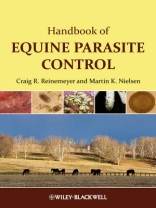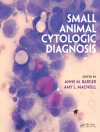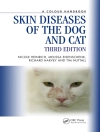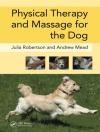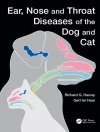A must-have guide for any equine veterinarian, this is apractical and concise handbook on the control of equineparasites. It enables you to advise your clients effectivelyon evidence-based parasite control programs. The first section ofthe book reviews the basic biology of internal parasites and thefactors influencing their transmission. The second sectiondiscusses the general principles of parasite control. The thirdsection provides diagnostic and assessment tools for interpretingclinical, historical and laboratory information. Finally thefourth section contains 20 case studies reflecting the full rangeof parasites and providing detailed answers and discussions, providing you with the opportunity to practice the application ofknowledge and illustrating the concepts of modern parasitecontrol.
Handbook of Equine Parasite Control is an invaluablecompanion for equine veterinary practitioners, veterinary students, equine veterinary technicians and nurses, researchers in equineparasitology, horse owners, and farm and stable managers.
Inhoudsopgave
Preface vii
Acknowledgments ix
SECTION I Internal Parasites and Factors Affecting Their Transmission 1
1 Biology and Life Cycles of Equine Parasites 3
2 Pathology of Parasitism and Impact on Performance 24
3 Environmental Factors Affecting Parasite Transmission 45
4 Host Factors Affecting Parasite Transmission 53
5 Parasite Factors Affecting Transmission 58
SECTION II Principles of Equine Parasite Control 67
6 Decreasing Parasite Transmission by Nonchemical Means 69
7 Pharmaceutical Approaches to Parasite Control 80
SECTION III Diagnosis and Assessment of Parasitologic Information 101
8 Diagnostic Techniques for Equine Parasitism 103
9 Detection of Anthelmintic Resistance 128
10 Evaluating Historical Information 138
11 Synopsis of Evidence-Based Parasite Control 145
SECTION IV Case Histories 153
Case 1 Mystery Drug 155
Case 2 Pyrantel Efficacy Evaluation 158
Case 3 Egg Count Results From Illinois Yearlings 160
Case 4 Colic and Parasites 163
Case 5 Confinement after Deworming 166
Case 6 Abdominal Distress in a Foal 168
Case 7 Quarantining Advice 171
Case 8 Diarrhea and Colic 173
Case 9 Foal Diarrhea 176
Case 10 Oral Lesion 179
Case 11 Skin Lesion 181
Case 12 Legal Case 184
Case 13 Repeated Egg Counts 186
Case 14 Repeated Colic 189
Case 15 Ivermectin Efficacy 193
Case 16 Ten Commandments 195
Case 17 Ivermectin Egg Reappearance 198
Case 18 Name that Worm 201
Case 19 Parasite Control for Yearlings 203
Case 20 Reaction to Treatment 205
Index 207
Over de auteur
Craig R. Reinemeyer graduated from the Ohio State University College of Veterinary Medicine in 1976, and spent 5years in mixed animal practice before returning to OSU to pursue a Ph D in veterinary parasitology. He was a faculty member ofthe University of Tennessee College of Veterinary Medicine from1984 to 1998, and served as the President of the American Association of Veterinary Parasitologists from 2003 to 2004. In 1997, Dr. Reinemeyer founded East Tennessee Clinical Research, acontract research organization that conducts pharmaceutical studiesto facilitate the development of new veterinary drugs. ETCR’s efforts have contributed to the approval of severalcurrently marketed anthelmintics for horses, cattle, andpets.
Martin K. Nielsen is Assistant Professor in the Department of Veterinary Science of the Maxwell H. Gluck Equine Research Center at the University of Kentucky. He has a doctoratefrom the University of Copenhagen, and was a faculty member therefor four years before moving to Kentucky. His research interestsinclude endoparasite infections of horses, clinical and moleculardiagnosis, epidemiology, surveillance, and control.
